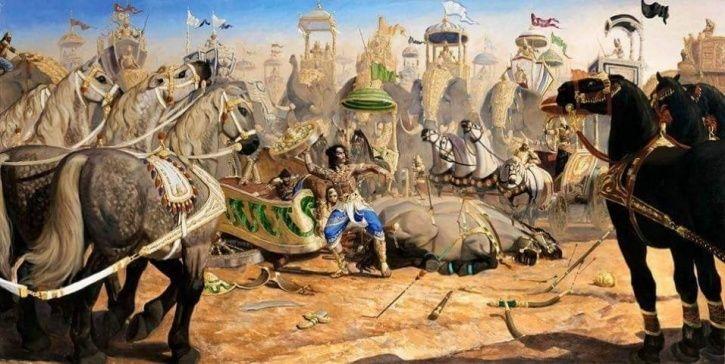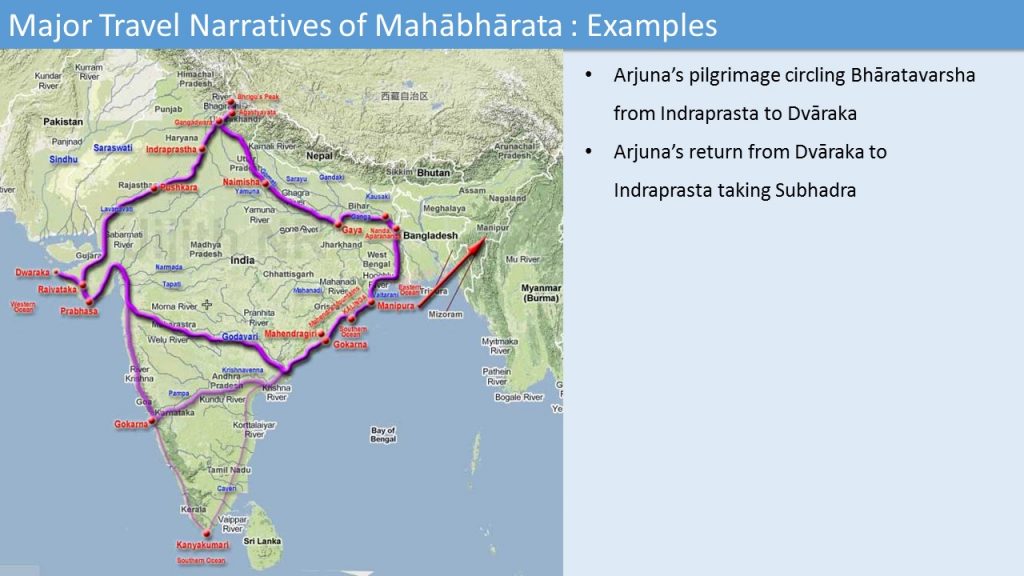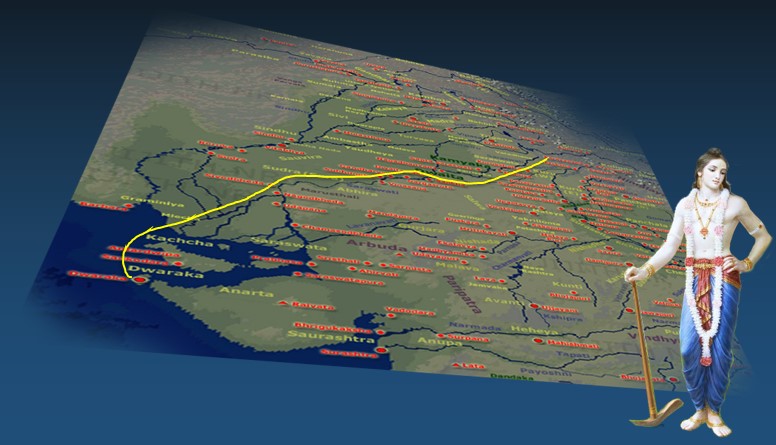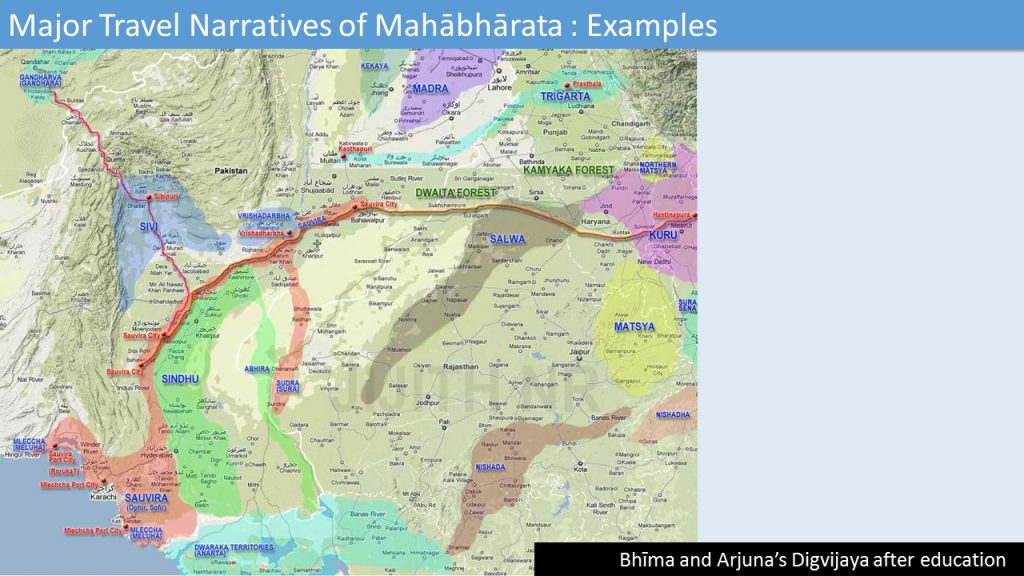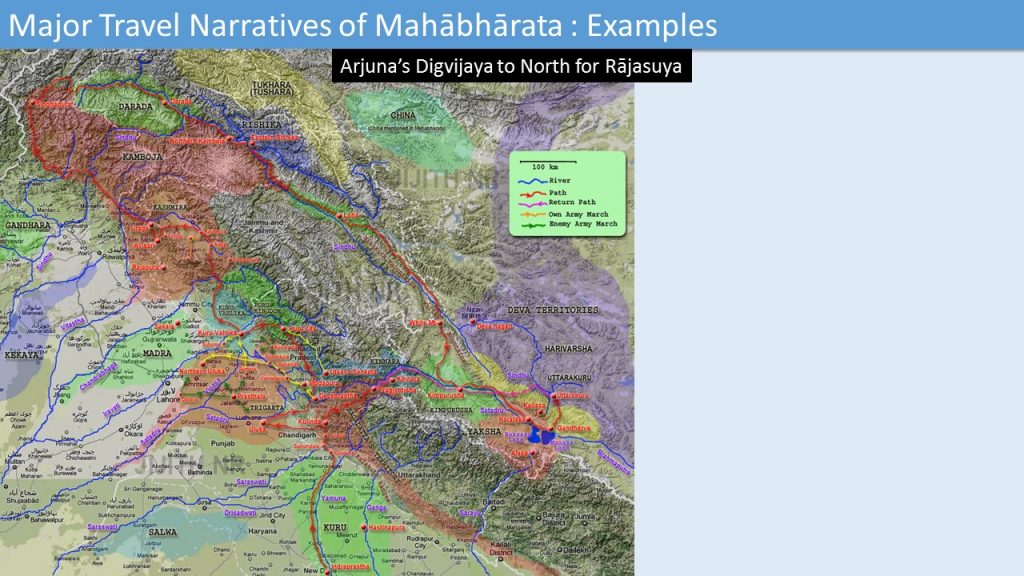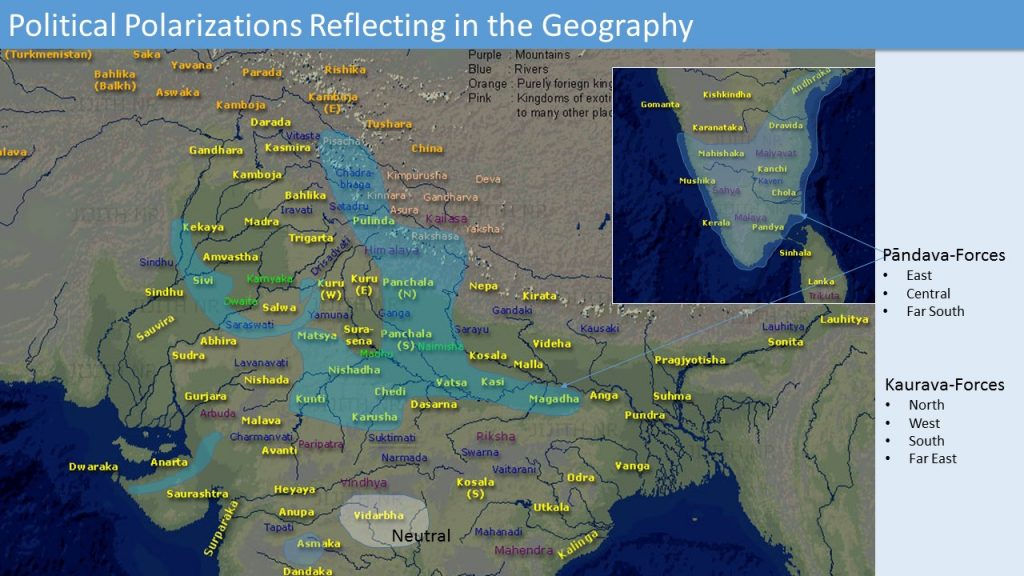The Travel Narratives: The Emergence of Bhārata as a Union
Travel Narratives connects one place with another revealing the travel networks crisscrossing Bhāratavarsha. This shows how different parts of Bhāratavarsha are inter-related. The flux of the ancient people and their movements within Bhāratavarsha is revealed in these travel narratives, leading to a sense of Bhāratavarsha as a common cultural and geographical union. This was the precursor to the nationhood of Bhārata as we see today. Mahābhārata is thus the foundation of India’s nationhood.
The travel narratives in the Mahābhārata can be classified into journeys from one place to another, circuitous pilgrimages usually around Bhāratavarsha (Bhārata-Paryatana) and Military Travels (Digvijayas and troop movements as part of battles).
The following is a list of the major travel narratives in the Mahābhārata:-
Journeys
- Pāndu’s journeys in Himālayas and stay at Śatasringa (Figure 18)
- Pāndava’s journeys in Śatasringa, Haistinapura, Pramānakoti and Vāranāvati
- Pāndava’s wandering from Vāranāvati to Ekachakra and Kāmpilya (Figure 19)
- Bhīma, Arjuna & Krishna’s travel to Magadha to kill Jarāsandha (Figure 19)
- Pāndava’s shift from Hastinapura to Kāmyaka and Dwaita forests
- Arjuna’s travel in Devabhūmi as he went there seeking Pāsupata weapon and divine weapons
- Pāndava’s shift from Kāmyaka to Virāta’s city
- Arjuna’s travel to submerging Dvaraka and Return
- The final journey of the Pāndavas – the Mahāprasthana
- Wanderings of Nala as described in the Nala-Damayanti sub narrative
- Wanderings of Satyavān & Sāvitri in a sub narrative
- Travels of Rāma (in a crisp Rāmayana embedded in the Vana Parva of Mahābhārata)
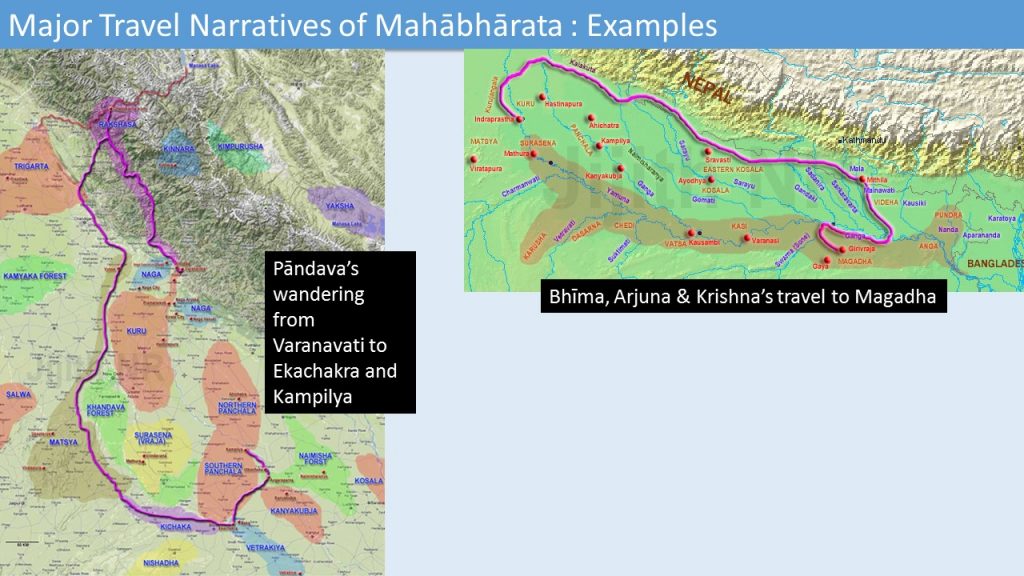
Figure 19: Pāndava’s journey from Vāranāvati to Ekachakra & Kāmpilya, Bhīma, Arjuna & Krishna’s travel from Indraprasta to Magadha
Pilgrimages
- Arjuna’s pilgrimage, circling Bhāratavarsha as penance for seeing Draupadi in the chamber of Yudhisthira (Figure 20)
- Pilgrimages of Pulastya, Dhaumya and other sages circling Bhāratavarsha
- Yushirthira’s pilgrimage circling Bhāratavarsha from Dwaita-Kamyaka forests and returning back, while waiting for the return of Arjuna from Dēvabhūmi
- Balarama’s pilgrimage along Sarasvati from Dvaraka to Kurukshetra while the Kurukshētra ware was taking place (Figure 21)
Military Travels
- Rājasūya Digvijaya
- Arjuna’s Digvijaya to north (Figure 23)
- Bhīma’s Digvijaya to east
- Nakula’s Digvijaya to west
- Sahadeva’s Digvijaya to outh
- Aśvamēdha Digvijaya
- Arjuna’s military campaign circling Bhāratavarsha for the post War Aśvamēdha
- Digvijaya
- Pāndu’s Digvijaya after ascending the throne of Hastinapura (Figure 18)
- Bhīma and Arjuna’s Digvijaya after their military education (Figure 22)
- Karna’s Digvijaya for the sake of Duryōdhana while Pāndavas were in exile
- Battles Movements
- Kuru-Pāndava attack on Pāncāla to present Drupada as the preceptor’s fee to Drōna
- Trigarta-Kaurava attack on Matsya while Pāndavās were staying incognito in Matsya kingdom
- Arjuna’s attack on Kālakeyas during his stay at Dēvabhūmi
- Deployment of Kuru Pāndava armies around Kurukshetra for the Kurukshetra War
Political Polarizations of Kurukshētra War, Reflecting in the Geography
The table below summariz the political polarization of kingdoms participated in the Kurukshētra War.
The kingdoms to the east, south and north of Kuru Rāshtra, viz. Pāncāla, Matsya and the Rākshasas under Ghatotkacha supported the Pāndavas. Pāchala king Drupada was the father in law of the Pāndavas. Matsya king Virāta was the father in law of Arjuna’s son Abhimanyu. The kingdoms to the east of Pāncāla like Vatsa, Kāśi, Kōsala (rebels) and Magadha and the kingdoms to the south of Matsya and Pāncāla like Nishadha, Chēdi, Kunti and Kārusha too supported the Pāndavas. Pāndavas had marital illiances with these kingdoms. Chēdi king Dhristakētu was a great ally. Magadha king Sahadēva too was a great ally. An alliance that Krishna made with the southern kingdom of Pāndyas paid off as Pāndyās, Kēralās and Chōlās supported the Pāndavas. This could also be a later interpolation as it is not clear how the forces from far south reached the Pāndavas in time. Apart from this, the rebel factions among the Yādavās under Sātyaki who was a disciple of Arjuna supported the Pāndavas. These forces were collected from Dvāraka, Ānarta and eastern Kuru (Kurujangala). The rebels among the Kēkayas, viz. the five Kēkaya brothers who lost the kingdom to cousin brothers much like the Pāndavas lost their kingdom to the Kauravas, too supported the Pāndavas. Rebels of Kānchi and Aśmaka too supported the Pāndavas. Some Kāmboja warriors who fight on any side on receiving payment too supported the Pāndavas.
However the rebels from Magadha, Kāśi, Matsya and Chēdi, opposed to Magadha king Sahadēva, the Kāśi king, the Matsya king Virāta and the Chēdi king Dhristakētu supported the Kauravas. Brihadbala, the main king of Kōsala, supported Kauravas. The Rākshasa rebels like Amabusha opposed to Ghatotkacha supported the Kauravas. The Madra king, Śalya the maternal uncle of the Pāndava twins, was forced to support the Kauravas. Main leaders of the Yādavās like Kritavarma supported the Kauravas. Almost all the other kingdoms in the west, north, east and south supported the Kauravas. The major allies of the Kauravas were the Trigartas, the Salvas, the Gāndhāras, the Sindhu-Sauviras, the Bāhlikās, the Darada-Kāmbojas, the Anga-Vanga-Kalingas, the Avantis, the Dāśārnas and the Kirātas under king Bhagadatta.
The many Yādavā kingdoms, the Matsya kingdoms, the Rākshasa kingdoms and the kingdoms like the Kēkaya, Magadha, Kāśi, Kōsala, Chēdi, Aśmaka, Kānchi where polarized within as they fought the war on both the sides. The kingdom of Vidarbha ruled by Rukmi stayed away from the battle.
References
- Electronic Sāmskrit text of the Mahābhārata (Devanagari and transliteration of Devanagari, Sacred Text Website – Prof. Muneo Tokunaga of Kyoto (creator), John D. Smith (editor) – http://sacred-texts.com/hin/mbs/index.htm
- Mahābhārata Wiki:- Wikified Electronic English text of the Mahābhārata, AncientVoice Website – Jijith Nadumuri Ravi (based on Kisrari Mohan Ganguli’s translation of the Bengal edition of Mahābhārata)- http://wikidot.com/source:mahabharata
- Bhāratavarsha Kingdom map and City map – Jijith Nadumuri Ravi ( based on the analysis of the geographical data in the Mahabhārata) – http://wikidot.com/bharatavarsha#toc5
- Geography, Peoples and Geodynamics of India in Purānas and Epics, A Geologist’s Interpretation – KS Valdiya – 2012 – Aryan Books International – ISBN 978-81-7305-422-8 (HB), ISBN 978-81-7305-431-0 (PB)
The paper was presented as part of the Mahābhārata Manthan International Conference Delhi – July 19th to 21st, 2017.
Featured Image: Giampaolo Tomassetti
Disclaimer: The opinions expressed within this article are the personal opinions of the author. IndiaFacts does not assume any responsibility or liability for the accuracy, completeness, suitability, or validity of any information in this article.
Jijith Nadumuri Ravi is the founder of the Website AncientVoice which contains 23500 pages on Mahabharata,Ramayana, the four Vedas and Vishnu Purana. It contains ancient India maps, analysis articles, lineage maps, the full text of English translation of these texts in Wikified form with 7000 plus nouns analysed creating huge information networks of Indic texts. The author additionally hosts websites like Naalanda, Takshasila and RecentVoice, focusing on Greek, Avestan and Tamil literature. He was a former ISRO scientist (2001-2006) and an artist who loves to paint events from Mahabharata.

